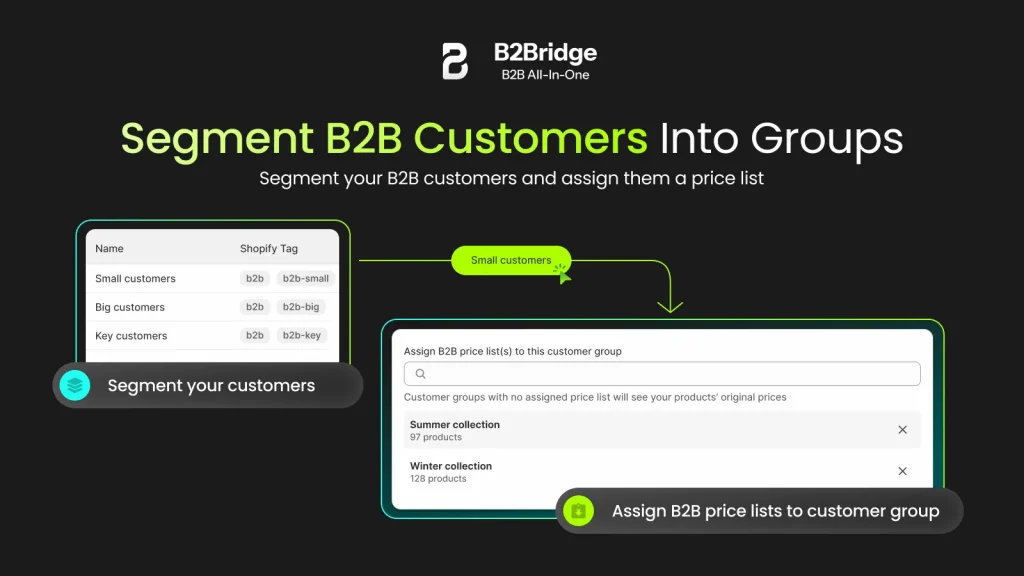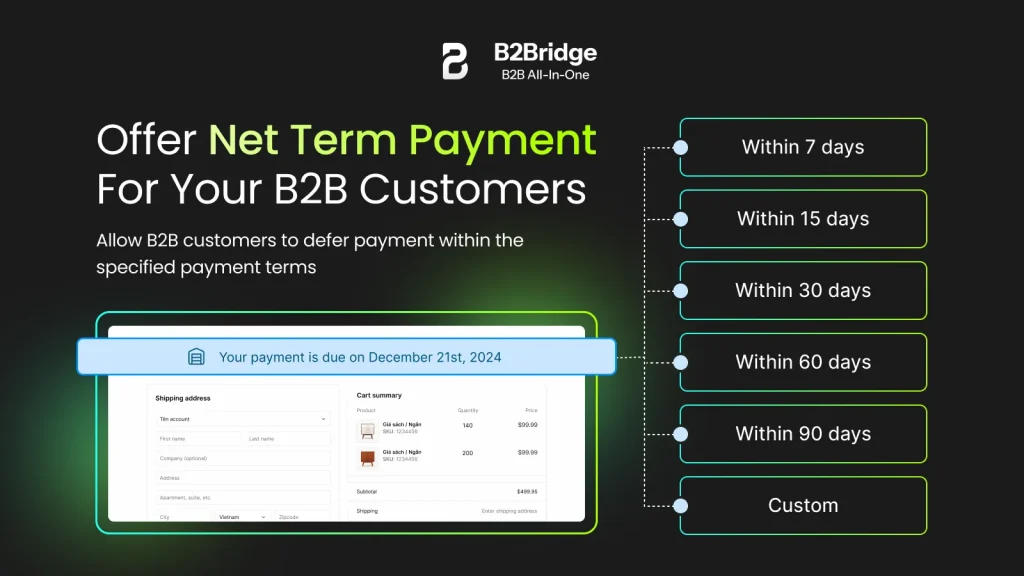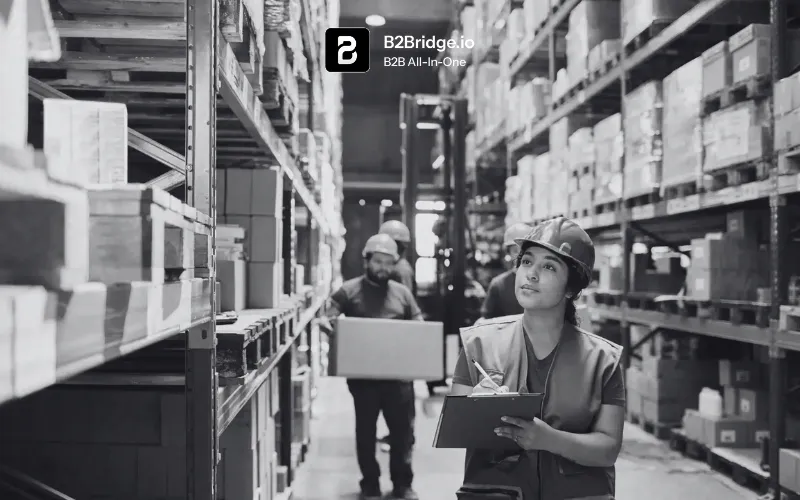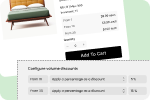Shopify has evolved far beyond its roots as a consumer-focused Ecommerce platform. Today, thousands of businesses leverage Shopify to power both their direct-to-consumer (B2C) retail operations and their business-to-business (B2B) wholesale channels – often from the same platform infrastructure. This Shopify B2B and B2C hybrid approach represents a significant opportunity for businesses looking to maximize efficiency while serving multiple customer segments.
In this comprehensive guide, you’ll discover the proven setup options for Shopify B2B and B2C hybrid operations, strategic considerations for managing both channels effectively, industry best practices from successful merchants, emerging wholesale pricing trends, and actionable guidance for optimizing your hybrid store.

Understanding Shopify B2B and B2C Hybrid Model
Defining the Hybrid Model
A Shopify B2B and B2C hybrid model refers to an operational approach where a single business uses the Shopify platform to serve both business customers (wholesalers, retailers, distributors) and individual consumers through integrated or connected storefronts. Rather than maintaining completely separate Ecommerce systems for each customer type, hybrid merchants leverage Shopify’s infrastructure to power both channels.
This can take several forms: a single Shopify store that delivers different experiences based on customer login status, multiple connected Shopify stores with shared backend systems, or a primary store enhanced with B2B-specific apps and middleware that add wholesale functionality.

Key benefits of the hybrid approach include:
- Unified management: Oversee both channels from one platform, reducing the learning curve and operational complexity
- Shared product catalog: Maintain a single source of truth for product information, reducing data entry duplication
- Cost efficiency: Leverage one Shopify subscription and shared apps rather than paying for completely separate systems
- Integrated inventory: Gain real-time visibility into stock levels across both channels, preventing overselling
- Consolidated analytics: View comprehensive business performance across retail and wholesale in unified dashboards
- Operational synergy: Apply learnings from one channel to improve the other, creating flywheel effects
Key Differences Between B2B and B2C in Shopify Context
While hybrid operations share infrastructure, understanding the fundamental differences between B2B and B2C commerce remains essential for success.
B2B wholesale operations typically involve longer, more complex buying cycles. Wholesale buyers research suppliers carefully, often require approval from multiple stakeholders, and make purchasing decisions based on factors like reliability, pricing consistency, and payment term flexibility. Orders tend to be larger in volume, purchases happen on regular cycles, and relationships develop over months or years.
Transform your B2B store with B2Bridge.
Discover how B2Bridge can transform your wholesale business.
Schedule a demo today to see our payment management tools in action.
B2C retail operations move much faster. Consumers make quick purchasing decisions, often impulse-driven or influenced by promotions and social proof. Order values are typically smaller, frequency varies widely by product category, and customer lifetime value builds through repeated individual transactions.
Key operational differences in the Shopify context:
- Customer journey: B2B involves account registration with approval workflows, assigned sales representatives, and negotiated terms; B2C supports immediate guest checkout and simple account creation
- Order volume and value: B2B orders are larger quantities at wholesale prices; B2C orders are individual units at retail prices
- Pricing structures: B2B requires customer-specific pricing, volume discounts, and contract pricing; B2C uses standard retail prices with occasional promotions
- Payment methods: B2B buyers expect Net payment terms (Net 30, Net 60, Net 90), invoice options, and credit accounts; B2C customers pay immediately via credit cards or digital wallets
- Checkout flow: B2B checkouts may include purchase order numbers, approval steps, and shipping to multiple locations; B2C checkouts prioritize speed and simplicity
- Product information: B2B buyers need technical specifications, case pack quantities, and wholesale terms; B2C shoppers want lifestyle imagery, reviews, and usage inspiration
Shopify Hybrid Setup Options and Configurations
Single Store with Role-Based Customization
The most streamlined approach to a Shopify B2B and B2C hybrid operation involves using one Shopify store that delivers different experiences based on customer login status and assigned roles.
With this configuration, you create customer tags or utilize Shopify’s B2B features to segment your audience. Retail customers see standard product pages with consumer pricing and checkout for immediate payment. When wholesale buyers log in, they access custom price lists, view bulk pricing tiers, and have access to B2B-specific features like Net payment terms.
You can customize the shopping experience using Shopify’s Liquid templating language to show or hide content based on customer tags, display different navigation menus for wholesale buyers, or present entirely different product collections depending on user type.

Advantages of the single store approach:
- Simplified inventory management with one source of truth for stock levels
- Single content management system for products, policies, and store information
- Lower subscription costs (one Shopify plan instead of multiple)
- Easier team training with one admin interface to learn
- Consolidated customer data for comprehensive business intelligence
Potential limitations:
- Limited ability to create dramatically different visual experiences for each customer type
- Pricing display can become complex when managing multiple price lists in one storefront
- Checkout customization requires workarounds to support vastly different flows
- Theme limitations may constrain B2B-specific features you can implement
- Risk of accidentally exposing wholesale pricing or content to retail customers
Multiple Stores with Shared Backend or Integrations
For businesses requiring greater separation and customization, running multiple Shopify stores – one for B2C retail and another for B2B wholesale – offers maximum flexibility while still maintaining integration between systems.
This approach involves creating separate Shopify storefronts with distinct domains, branding, and customer databases. You then connect these stores through middleware, ERP systems, or specialized apps that synchronize inventory levels, product information, and order data across both stores.
The separate stores architecture allows you to design each storefront specifically for its audience. Your retail store can emphasize visual merchandising, storytelling, and consumer-friendly navigation, while your wholesale store delivers the professional, efficient ordering interface that B2B buyers expect.
Benefits of multiple connected stores:
- Complete customization freedom for each channel’s user experience
- Clear data segregation between retail and wholesale operations
- Independent optimization and testing without cross-channel interference
- Ability to use different apps and features tailored to each channel’s needs
- Professional B2B branding separate from consumer brand identity
Operational considerations:
- Higher maintenance requirements managing multiple storefronts
- Additional subscription costs for multiple Shopify plans
- Need for reliable synchronization tools to keep inventory accurate
- More complex reporting requiring data consolidation from multiple sources
- Increased training complexity for staff working across both stores
Hybrid Middleware and Apps
A third approach gaining popularity combines the simplicity of a single store with enhanced B2B functionality through specialized apps and middleware. B2Bridge and similar wholesale solutions add sophisticated B2B features to your existing Shopify store without requiring separate storefronts.
These apps integrate directly with Shopify’s native B2B infrastructure, extending capabilities around customer management, pricing control, payment terms, and wholesale workflows. You maintain one store but gain the ability to deliver professional B2B experiences that rival dedicated wholesale platforms.
This middleware approach works well for businesses that want more B2B functionality than a basic single-store setup provides but don’t need or can’t justify the complexity of separate stores.
Example use cases:
A fashion brand using B2Bridge serves retail consumers through their standard storefront while wholesale buyers – boutique owners and retailers – log in to access special wholesale collections, volume-based pricing tiers, and Net 60 payment terms. The app handles customer registration approval, hides wholesale prices from retail visitors, and automates order workflows, all within one Shopify store.
A specialty food company uses B2B apps to manage hundreds of wholesale accounts with customer-specific pricing while simultaneously selling to consumers through the same product catalog. The middleware automatically applies the correct pricing based on customer login, manages credit limits, and sends invoices for Net 30 terms – all happening seamlessly in the background.
Best Practices for Managing Shopify B2B and B2C Hybrid
Master Product and Catalog Management
Effective catalog management forms the foundation of successful hybrid operations. Your product information needs to support both retail storytelling and wholesale efficiency without creating maintenance nightmares.
Structure your product catalog with flexibility in mind. Use Shopify’s metafields to store wholesale-specific information like case pack quantities, minimum order quantities, and trade item identifiers without cluttering retail product pages. Create separate collections that segment products by channel – some items may be retail-exclusive, others wholesale-only, while many products serve both segments.

Implement pricing structures that scale across customer types. Shopify’s price lists feature allows you to maintain retail prices as your base while applying wholesale pricing tiers, customer-specific discounts, and volume-based pricing rules. This ensures pricing accuracy without manual updates across multiple locations.
Catalog management tips:
- Use location-based catalog features to show different product assortments to wholesale buyers in different regions
- Implement customer group pricing that automatically applies appropriate rates based on buyer classification
- Create clear product variants that make sense for both bulk wholesale orders and individual consumer purchases
- Maintain consistent SKUs and product identifiers across channels for inventory accuracy
- Develop tagging strategies that enable filtering and segmentation without creating confusion
- Schedule product launches and seasonal updates to roll out consistently across both channels
Seamless Buyer Experience
The shopping experience must feel native and appropriate for each customer type, even within a hybrid setup.
For B2B buyers, prioritize efficiency and functionality. Implement quick reorder capabilities that let wholesale customers duplicate previous orders with one click. Create self-service account portals where buyers can view order history, track shipments, download invoices, and manage payment methods independently. Design navigation that helps buyers find products by category, SKU, or previous purchase rather than relying on inspirational browsing.
For B2C customers, maintain the engaging, discovery-focused experience that drives consumer conversions. Feature promotional content prominently, showcase user-generated content and reviews, and guide shoppers through curated collections that tell your brand story.
Experience optimization strategies:
- Implement role-based UI modifications that adjust navigation, product display, and calls-to-action based on customer type
- Create dedicated account management dashboards for B2B buyers with wholesale-relevant tools and information
- Design mobile experiences optimized for each audience – consumers shopping on smartphones versus buyers reviewing catalogs on tablets
- Use progressive disclosure to show complexity only when needed, keeping the interface clean for simple transactions
- Provide multiple product discovery paths – browsing for consumers, search and bulk upload for wholesale buyers
Optimize Checkout and Payment Terms
The checkout experience represents where B2B and B2C requirements diverge most dramatically, making this a critical optimization area for hybrid stores.
Shopify now supports diverse payment configurations including multiple payment gateways for instant consumer payments alongside custom B2B payment terms. Modern wholesale buyers expect flexible payment options – particularly Net 30, Net 60, and Net 90 terms that allow them to receive and potentially resell products before payment is due.

Configure your checkout to present appropriate payment options based on customer type. Retail customers see standard payment methods – credit cards, PayPal, Shop Pay, and other instant payment options. Wholesale buyers with approved accounts see their assigned payment terms, purchase order number fields, and invoice payment options.
Payment and checkout strategies:
- Implement credit application workflows that evaluate wholesale buyers before extending payment terms
- Use deposit requirements for new wholesale accounts while building credit history
- Manage credit limits per customer to control risk exposure on Net payment terms
- Integrate invoice payment tracking with your accounting system for seamless AR management
- Create different checkout flows that collect relevant information for each customer type – gift messages for consumers, purchase orders for businesses
- Set up automated payment reminders that notify wholesale buyers before invoice due dates
Integrate ERP and Automation Tools
As your hybrid operation scales, manual processes become unsustainable. Integration with Enterprise Resource Planning (ERP) systems and automation tools transforms operational efficiency.
ERP integration synchronizes critical data between Shopify and your backend business systems – inventory levels update in real-time, orders flow directly to fulfillment systems, and customer information stays consistent across platforms. This eliminates duplicate data entry, reduces errors, and provides single-source truth for business operations.
Modern Shopify apps and middleware enable automation for many manual touchpoints that typically slow hybrid operations. Automatically approve wholesale customer registrations based on verification criteria, update price lists based on cost changes or promotional schedules, and route orders to appropriate fulfillment centers based on customer type or location.
Integration and automation opportunities:
- Sync inventory across retail and wholesale channels in real-time to prevent overselling
- Automate customer onboarding workflows that collect required documentation and approve accounts
- Connect accounting systems to eliminate manual invoice creation and payment reconciliation
- Implement order approval workflows for wholesale purchases exceeding credit limits
- Use inventory forecasting tools that account for both retail and wholesale demand patterns
- Set up automated reporting that consolidates performance metrics across both channels
Marketing and Customer Engagement
Marketing strategies must reflect the fundamental differences between relationship-driven B2B and transaction-focused B2C approaches while leveraging shared brand assets.
B2B marketing in a hybrid context emphasizes relationship building, industry expertise, and business value propositions. Wholesale buyers want to partner with reliable suppliers who understand their business needs. Your marketing should demonstrate industry knowledge, showcase your capacity to fulfill large orders consistently, and highlight the business benefits of carrying your products.
B2C marketing drives individual transactions through emotional connections, social proof, and promotional offers. Consumer campaigns create urgency, leverage influencer partnerships, and build community around your brand values.
Marketing best practices for hybrid operations:
- Develop personalized outreach campaigns for wholesale buyers based on purchase history and business type
- Create separate email flows for B2B and B2C that deliver relevant content and offers to each segment
- Implement loyalty programs appropriate to each channel – volume rebates for wholesale, points programs for retail
- Use account-based marketing tactics to nurture high-value wholesale prospects
- Leverage omnichannel selling strategies that allow B2B buyers to order online, via sales reps, or through customer service
- Maintain consistent brand voice across channels while adjusting messaging for business versus consumer audiences
- Share wholesale success stories and retail customer testimonials in channel-appropriate format
Shopify B2B and B2C Hybrid: Case Studies and Examples
Many brands successfully operate Shopify B2B and B2C hybrid models, demonstrating the viability of this approach across industries.
Specialty beverage companies often start with direct-to-consumer sales through Shopify, then add wholesale channels to reach retail stores and restaurants. By implementing B2B features within their existing store, they maintain brand consistency across channels while serving both customer types. These brands report 40-60% faster wholesale channel launch compared to building separate systems, with the added benefit of unified inventory management preventing stock-outs.
Artisan food producers leverage hybrid setups to sell directly to consumers while supplying specialty grocery stores and food service operations. By using customer-specific pricing and segmented catalogs, they protect retail pricing while offering volume discounts to wholesale accounts. Many report that the efficiency gains from managing one catalog versus separate systems allow them to focus on product development and customer relationships rather than administrative overhead.

Fashion and apparel brands use Shopify’s hybrid capabilities to sell directly to consumers while supplying boutiques and retailers with wholesale inventory. The ability to offer Net 60 terms to established retail partners while maintaining instant payment for consumers creates flexibility that supports both channels’ growth. Brands implementing professional B2B experiences within their existing retail infrastructure report 25-35% increases in wholesale order frequency as buyers find the ordering process more convenient.
These examples demonstrate that with proper configuration and the right tools, Shopify B2B and B2C hybrid operations deliver sustainable growth across multiple customer segments.
Can you do B2B and B2C at the same time? How?
Yes, absolutely. Shopify supports hybrid B2B and B2C operations through its native B2B features combined with customer segmentation. You create company profiles for wholesale buyers, assign them custom price lists, and configure payment terms appropriate for business customers. Use customer tags and conditional logic in your theme to show different content based on whether someone is logged in as a retail or wholesale customer. Many merchants enhance this basic setup with B2B apps like B2Bridge that add more sophisticated wholesale features.
As you build or optimize your hybrid operation in 2026, focus on the fundamentals: master your catalog management, deliver seamless experiences appropriate to each customer type, implement flexible payment options including Net terms for wholesale buyers, leverage automation to eliminate manual bottlenecks, and develop marketing strategies that speak to business and consumer audiences appropriately.
Whether you’re launching wholesale operations or optimizing an existing B2B channel within your hybrid Shopify store, B2Bridge provides a comprehensive solution that makes managing both channels seamless.
B2Bridge is an all-in-one B2B Shopify app designed to seamlessly integrate B2B functionality into your existing Shopify store, enabling you to run a hybrid B2C and B2B operation from a single setup. Its core features empower wholesale sellers to scale efficiently without needing Shopify Plus or separate storefronts. Key highlights include:
- Custom price lists with volume discounts, tiered pricing, and purchase limits that tailor the buying experience for different B2B customer groups
- Customer group segmentation with exclusive access controls to hide wholesale content and prices from retail shoppers
- Flexible payment options, including net payment terms like Net 15, Net 30, and Net 60, supporting invoice and credit payment workflows
- Streamlined B2B ordering experience with quick order forms, CSV uploads, product lists, and one-click reordering for bulk buyers
- Professional registration forms to verify wholesale customers and gate access to B2B portals
- Replaces Shopify’s default product and cart pages for B2B buyers with optimized interfaces for faster, efficient ordering
- Centralized admin to manage products, customers, orders, and pricing in one unified dashboard without operational overhead
Built specifically for Shopify’s B2B infrastructure, B2Bridge works seamlessly whether you choose a single store approach or multiple connected stores, giving you the flexibility to evolve your hybrid setup as your business grows.
FAQs about Shopify B2B and B2C Hybrid
The optimal app stack depends on your specific needs, but most successful hybrid operations include: a comprehensive B2B app (like B2Bridge) for wholesale features, an ERP integration for inventory and order management, an email marketing platform that supports customer segmentation, and potentially a customer portal app for self-service account management. Look for apps specifically designed for B2B functionality rather than trying to retrofit retail-focused apps. Prioritize integrations that reduce manual work and keep data synchronized between systems. -> See B2Bridge’s features
Shopify supports both B2C and B2B selling. Originally designed for retail Ecommerce, Shopify now includes dedicated B2B features – such as customer accounts, volume pricing, payment terms, and wholesale catalogs – making it suitable for businesses serving both consumer and wholesale markets.
A combination of B2B and B2C is called hybrid commerce. It allows a business to sell to both individual consumers and business buyers, often using customer segmentation, pricing tiers, and tailored shopping experiences within one platform or across separate channels.
A blended B2B Shopify setup serves retail and wholesale customers in one storefront, using customer-specific rules to control pricing and access. A dedicated B2B store is a separate wholesale-only website designed exclusively for business buyers with its own workflows and experience.
The most common challenges include accidentally exposing wholesale pricing to retail customers, creating checkout flows that work well for both customer types, managing inventory across channels, and delivering appropriately different experiences within one storefront. Address these by implementing strict access controls on wholesale content, using B2B apps that handle checkout customization, maintaining accurate real-time inventory sync, and leveraging customer segmentation features to personalize the experience. Start simple and add complexity gradually as you understand your specific needs.
Conclusion
The Shopify B2B and B2C hybrid approach represents a powerful opportunity for businesses ready to serve multiple customer segments efficiently. When properly configured and managed with the right tools, hybrid operations deliver the best of both worlds – operational efficiency from shared infrastructure combined with customized experiences that meet each channel’s unique requirements.
Ready to optimize your Shopify B2B and B2C hybrid store? Discover how B2Bridge simplifies wholesale operations while maintaining the seamless retail experience your consumers love. Explore B2Bridge today and unlock the full potential of your hybrid Shopify store.






